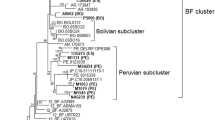Abstract
OUR understanding of the biology and origins of human immunodeficiency virus type 2 (HIV-2) derives from studies of cultured isolates from urban populations experiencing epidemic infection and disease1–8. To test the hypothesis that such isolates might represent only a subset of a larger, genetically more diverse group of viruses, we used nested polymerase chain reactions to characterize HIV-2 sequences in uncultured mononuclear blood cells of two healthy Liberian agricultural workers, from whom virus isolation was repeatedly unsuccessful, and from a culture-positive symptomatic urban dweller. Analysis of pol, env and long terminal repeat regions revealed the presence of three highly divergent HIV-2 strains, one of which (from one of the healthy subjects) was significantly more closely related to simian immunodeficiency viruses infecting sooty mangabeys and rhesus macaques (SIVSM/SIVMAC) than to any virus of human derivation. This subject also harboured multiply defective viral genotypes that resulted from hypermutation of G to A bases. Our results indicate that HIV-2, SIVSM and SIVMAC comprise a single, highly diverse group of lentiviruses which cannot be separated into distinct phylogenetic lineages according to species of origin.
This is a preview of subscription content, access via your institution
Access options
Subscribe to this journal
Receive 51 print issues and online access
$199.00 per year
only $3.90 per issue
Buy this article
- Purchase on Springer Link
- Instant access to full article PDF
Prices may be subject to local taxes which are calculated during checkout
Similar content being viewed by others
References
Guyader, M. et al. Nature 326, 662–669 (1987).
Zagury, J. F. et al. Proc. natn. Acad. Sci. U.S.A. 85, 5941–5945 (1988).
Franchini, G. et al. Proc. natn. Acad. Sci. U.S.A. 86, 2433–2437 (1989).
Kumar, P. et al. J. Virol. 64, 890–901 (1990).
Hasegawa, A. et al. AIDS Res. hum. Retrovir. 5, 593–604 (1989).
Kirchboff, F., Jentsch, K. D., Stuke, A., Mous, J. & Hunsmann, G. AIDS 4, 847–857 (1990).
Dietrich, U. et al. Nature 342, 948–950 (1989).
Schulz, T. F. et al. J. Virol. 64, 5177–5182 (1990).
Clark, S. J. et al. New Engl. J. Med. 324, 954–960 (1991).
Allan, J. S. et al. J. Virol. 65, 2816–2828 (1991).
Mullis, K. B. & Faloona, F. A. Meth. Enzym. 155, 335–350 (1987).
Myers, G., Berzofsky, J. A., Korber, B., Smith, T. F. & Pavlakis, G. N. Human Retroviruses and AIDS (Los Alamos National Laboratory, New Mexico, 1991).
Meyerhans, A. et al. Cell 58, 901–910 (1989).
Vartanian, J.-P., Meyerhans, A., Asjo, B. & Wain-Hobson, S. J. Virol. 65, 1779–1788 (1991).
Fitch, W. M. Syst. Zool. 20, 406–416 (1971).
Saitou, N. & Nei, M. Molec. biol. Evol. 4, 406–425 (1987).
Felsenstein, J. Evolution 39, 783–791 (1985).
Hirsch, V. M., Olmsted, R. A., Murphey-Corb, M., Purcell, R. H. & Johnson, P. R. Nature 339, 389–392 (1989).
T-W-Fiennes, R. N. Zoonoses and the Origins and Ecology of Human Disease (Academic, London, 1978).
Marx, P. A. et al. J. Virol. 65, 4480–4485 (1991).
Khan, A. S. et al. J. Virol. 65, 7061–7065 (1991).
Novembre, F. J., Hirsch, V. M., McClure, H. M., Fultz, P. N. & Johnson, P. R. Virology 186, 783–787 (1992).
Fultz, P. N., Gordon, T. P., Anderson, D. C. & McClure, H. M. AIDS 4, 619–625 (1990).
Letvin, N. L. et al. Science 230, 71–73 (1985).
Li, Y. et al. J. Virol. 65, 3973–3985 (1991).
Johnson, P. R., Hamm, T. E., Goldstein, S., Kitov, S. & Hirsch, V. M. Virology 185, 217–228 (1991).
Gilks, C. Nature 354, 262 (1991).
Kimura, M. J. molec. Evol. 16, 111–120 (1980).
Higgins, D. G., Bleasby, A. & Fuchs, R. Comp. appl. Biosci. 8, 189–191 (1992).
Swofford, D. L. PAUP: Phylogenetic Analysis Using Parsimony (Illinois Natural History Survey, Champaign, Illinois, 1991).
Author information
Authors and Affiliations
Rights and permissions
About this article
Cite this article
Gao, F., Yue, L., White, A. et al. Human infection by genetically diverse SIVSM-related HIV-2 in West Africa. Nature 358, 495–499 (1992). https://doi.org/10.1038/358495a0
Received:
Accepted:
Issue Date:
DOI: https://doi.org/10.1038/358495a0
This article is cited by
-
Evasion of cGAS and TRIM5 defines pandemic HIV
Nature Microbiology (2022)
-
Current and historic HIV-1 molecular epidemiology in paediatric and adult population from Kinshasa in the Democratic Republic of Congo
Scientific Reports (2020)
-
A conflict of interest: the evolutionary arms race between mammalian APOBEC3 and lentiviral Vif
Retrovirology (2017)
-
High Prevalences and a Wide Genetic Diversity of Simian Retroviruses in Non-human Primate Bushmeat in Rural Areas of the Democratic Republic of Congo
EcoHealth (2017)
-
Mechanistic differences between HIV-1 and SIV nucleocapsid proteins and cross-species HIV-1 genomic RNA recognition
Retrovirology (2016)
Comments
By submitting a comment you agree to abide by our Terms and Community Guidelines. If you find something abusive or that does not comply with our terms or guidelines please flag it as inappropriate.



